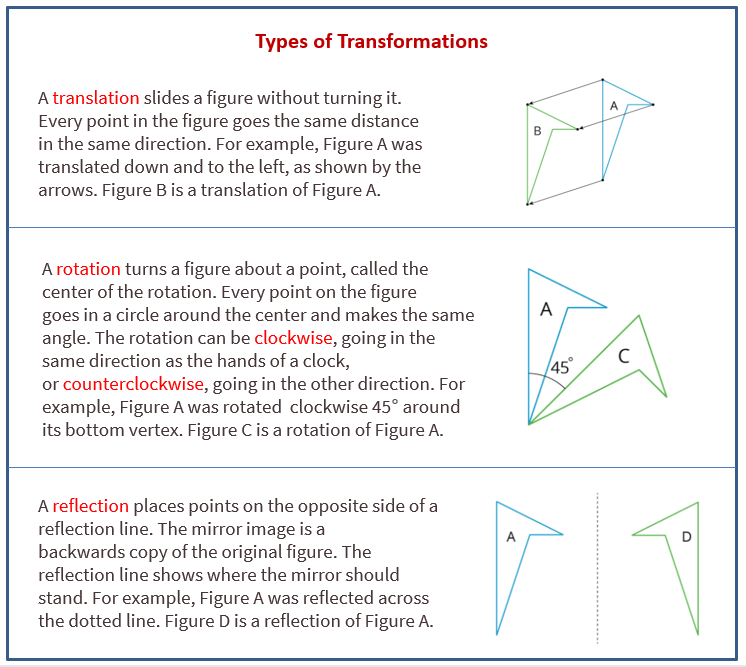Illustrative Mathematics Grade 8, Unit 1, Lesson 2: Naming the Moves
Learning Targets:
- I can identify corresponding points before and after a transformation.
- I know the difference between translations, rotations, and reflections.
Related Pages
Illustrative Math
Grade 7
Lesson 2: Naming the Moves
Let’s be more precise about describing moves of figures in the plane.
Illustrative Math Unit 8.1, Lesson 2 (printable worksheets)
Lesson 2 Summary
The following diagram shows the difference between translations, rotations, and reflections.

We use the word image to describe the new figure created by moving the original figure. If one point on the original figure moves to another point on the new figure, we call them corresponding points.
Lesson 2.1 A Pair of Quadrilaterals
Quadrilateral A can be rotated into the position of Quadrilateral B.
Estimate the angle of rotation
Lesson 2.2 How Did You Make That Move?
Here is another set of dance moves.
- Describe each move or say if it is a new move.
a. Frame 1 to Frame 2.
b. Frame 2 to Frame 3.
c. Frame 3 to Frame 4.
d. Frame 4 to Frame 5.
e. Frame 5 to Frame 6. - How would you describe the new move?
Lesson 2.3 Move Card Sort
Your teacher will give you a set of cards. Sort the cards into categories according to the type of move they show. Be prepared to describe each category and why it is different from the others. You can explore the applets below to see the ways the images move.
Drag the red point. Explore how the image changes.
Open Applet
Open Applet
Click on the box to show the transformed image.
Move the yellow points and the red segment to see how the image changes.
Open Applet
Glossary Terms
clockwise
Clockwise means to turn in the same direction as the hands of a clock. It is a turn to the right.
corresponding
When part of an original figure matches up with part of a copy, we call them corresponding parts. These could be points, segments, angles, or distances.
counterclockwise
Counterclockwise means to turn opposite of the way the hands of a clock turn. It is a turn to the left.
image
An image is the result of translations, rotations, and reflections on an object. Every part of the original object moves in the same way to match up with a part of the image.
reflection
A reflection across a line moves every point on a figure to a point directly on the opposite side of the line. The new point is the same distance from the line as it was in the original figure.
rotation
A rotation moves every point on a figure around a center by a given angle in a specific direction.
translation
A translation moves every point in a figure a given distance in a given direction.
Lesson 2 Practice Problems
- Each of the six cards shows a shape.
a. Which pair of cards shows a shape and its image after a rotation?
b. Which pair of cards shows a shape and its image after a reflection? - The five frames show a shape’s different positions.
Describe how the shape moves to get from its position in each frame to the next. - The rectangle seen in Frame 1 is rotated to a new position, seen in Frame 2.
Select all the ways the rectangle could have been rotated to get from Frame 1 to Frame 2.
a. 40 degrees clockwise
b. 40 degrees counterclockwise
c. 90 degrees clockwise
d. 90 degrees counterclockwise
e. 140 degrees clockwise
f. 140 degrees counterclockwise
The Open Up Resources math curriculum is free to download from the Open Up Resources website and is also available from Illustrative Mathematics.
Try out our new and fun Fraction Concoction Game.
Add and subtract fractions to make exciting fraction concoctions following a recipe. There are four levels of difficulty: Easy, medium, hard and insane. Practice the basics of fraction addition and subtraction or challenge yourself with the insane level.

We welcome your feedback, comments and questions about this site or page. Please submit your feedback or enquiries via our Feedback page.